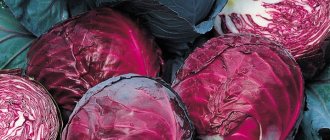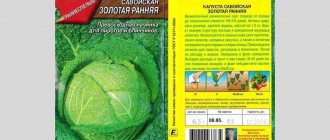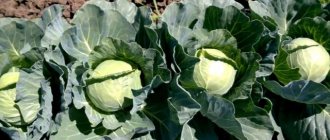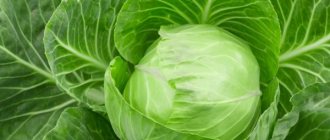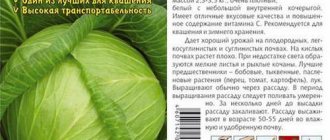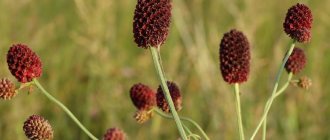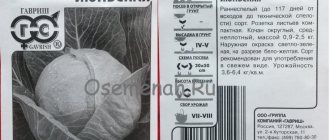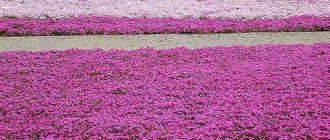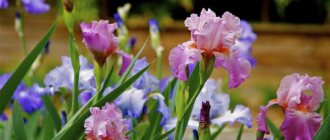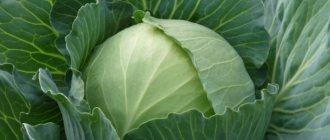Photo
Look how this amazing vegetable looks in the photo:
Difference from other species
The main difference between kohlrabi and other types of cabbage is the specific bulb-shaped shape of the stem with sparse leaves diverging to the sides. In appearance, this vegetable resembles a root vegetable more than cabbage. The taste of kohlrabi is similar to the stump of white cabbage, but sweeter and juicier.
Some still prefer the usual white cabbage varieties. We invite you to familiarize yourself with some of them: Nozomi, Kolobok, Sugarloaf, Slava, Valentina, Moscow late, Amager, Centurion F1, Gift and Zimovka.
Medium-ripening varieties of kohlrabi cabbage
The ripening period for mid-season kohlrabi varieties ranges from 80 to 120 days.
The productivity is quite high. The culture is resistant to cold climates and can take root in a wide variety of soils. The stem fruits are quite resistant to cracking.
Choose white cabbage!
• Cabbage Megaton f1 • Krautman F1 • Atria F1 • Sugarloaf • Aggressor F1 • JUNE
Kohlrabi "Madonna"
A unique variety bred by breeders in Holland. It is characterized by large fruits. They ripen on the 110th day.
The leaves have a bluish, green color and an oval shape.
The stem fruits are flat and round in shape. They are often elongated. Purple skin and white tasty flesh. The weight of one stem fruit ranges from 0.5 to 0.7 kg. The maximum weight can reach up to 1.3 kg.
The yield of the Madonna cabbage variety is constant, up to 4 kg per 1 m2.
Kohlrabi "Cartago F1"
Hybrid obtained in the Czech Republic. The ripening period of "Cartago F1" is influenced by climatic growing conditions. The leaves are oval-shaped and gray-green in color. There is a waxy coating. The stem fruits are round in shape, slightly flattened. The peel has a light green tint, and the flesh is white and juicy. The mass of the stem fruit ranges from 200 to 300 g.
Plants are resistant to lignification. Do not crack. The productivity of "Cartago F1" is at a high level - from 3 to 3.5 kg per 1 m2.
Kohlrabi cabbage "Eder RZ F1"
The variety has leaves of a bluish-green hue. The shape is oblong-oval. The leaves have light veins. The top is flat. Inside the Eder RZ fruit there is juicy, creamy-white pulp. The mass of the stem fruit reaches 400 g. Productivity is high. Reaches 3.6 kg per 1m2. Plants are not susceptible to cracking and lignification.
Advantages and disadvantages
The list of advantages of “cabbage-turnip” is quite long:
- Kohlrabi is a dietary product, but at the same time it has a rich content of vitamins and minerals.
- This is an early ripening and cold-resistant vegetable, therefore, even in the northern regions, it is possible to obtain several harvests per season.
- Cabbage does not require special conditions and careful care when growing.
It has a pleasant sweetish, juicy taste. Thanks to increased acidity, it improves appetite.
- Suitable for consumption raw, boiled, stewed. Pairs perfectly with a wide variety of dishes.
It is also worth noting the disadvantages of kohlrabi :
- Cabbage is very sensitive to over- and under-watering.
- Capable of accumulating nitrates, which are dangerous to the human body.
- With sharp fluctuations in ambient temperature, a young kohlrabi sprout develops into a “flower shoot”.
Description of the fetus: general external signs
The name of the plant is translated as “cabbage turnip” or “stem turnip” due to the peculiar shape of the stem. A small spherical or turnip-shaped fruit is formed by leaves of different sizes. The vegetable has a compressed, medium-density structure and a delicate taste. Cabbage leaves, which grow up to 30, are used to make salads. They are relatively large in size, have an elongated shape and are dark green in color. The foliage is located on the top of the turnip, which is completely white or purple.
Benefits and harms
Let's look at the benefits of kohlrabi cabbage. The vegetable's calorie content is low: 100 g of kohlrabi contains only 41.7 kcal, which makes it an excellent dietary product. At the same time, cabbage contains an increased amount of sugars - up to 7.9% and ascorbic acid (up to 140 mg/100 g), due to which kohlrabi is called the “northern lemon”.
The protein content in “cabbage-turnips” ranges from 1.2 to 2.8%, starch and fiber – from 1.5 to 2.2%. Kohlrabi is rich in vitamins and mineral elements (mg/100g): Vit C – 40 – 67.8; vit B1 -0.1; vit B2 – 0.04-0.08; potassium – 370; calcium – 46-75; magnesium 30-50; phosphorus – 50; sodium – 10-20.
Despite the many beneficial properties of kohlrabi, it is necessary to remember about contraindications to its use. People with pancreatic diseases and diseases of the stomach and intestines, accompanied by high acidity, should consume kohlrabi with caution. In such cases, cabbage can be combined with other products that neutralize its acid formation.
We invite you to watch a video about the benefits of kohlrabi:
Kohlrabi cabbage - reviews of varieties
Vladimir Petrovich, Rostov-on-Don, 42 years old
“I can’t live without kohlrabi. I immediately liked this vegetable because of its “exotic” appearance. When I learned about its beneficial properties, I decided to immediately grow it on my summer cottage. According to my personal observations, it is worth slightly growing the cabbage so that it is soft. I prefer purple late varieties.”
Anastasia Sergeevna, Minsk, 35 years old.
“I have been growing kohlrabi for two years. I chose “Blue Planet”; this cabbage feels great in open ground conditions. Its taste is soft and sweet, and the variety is easy to care for. Suitable for fresh consumption, for example, for vegetable salads, and for winter preparations. I often use it only fresh: this is the most healthy option.”
Alexander Igorevich, Voronezh, 52 years old
“I planted kohlrabi this year. I looked closely for a long time, at first I didn’t like the look. Then I read the description of the variety, reviews and decided to allocate a few meters for an overseas crop. I chose the Vienna White variety, the only one offered in the store. I planted it like this as a test, I didn’t even expect that I would get a good harvest, because I hardly looked after it. I gained respect for this culture. I will continue to grow kohlrabi cabbage. I recommend it for beginner gardeners."
Growing and care in open ground
Let's take a closer look at how to grow kohlrabi and what care it needs.
Where and for how much can I buy seed material?
In Moscow, the price of kohlrabi ranges from 9 to 51 rubles, depending on the variety . You can buy cabbage in such large chain stores as “7 Seeds”, “Garden and Vegetable Garden”, “Agro SOS”. In St. Petersburg, in stores such as “Planet Sadovod”, “Argo”, “Urozhay”, “Garden and Seeds”, kohlrabi cabbage can be purchased at prices ranging from 10 to 56 rubles.
When to plant seeds?
They begin to sow kohlrabi in open ground in central Russia in early to mid-May, when the average daily temperature does not drop below +10°C.
We invite you to watch a video about the timing of planting calrabi:
Selecting a location
You should not plant kohlrabi in places where any other type of cabbage grew the year before , as this increases the likelihood of pest infestation. Also bad predecessors are rutabaga, radish, radish. “Cabbage-turnips” will grow better in soil where legumes, nightshades, and beets were previously planted.
Reference! Sunlight promotes the growth of kohlrabi, but partial shade is also acceptable.
Soil requirements
The soil does not play a special role, but kohlrabi grows best in light and moist soil, rich in humus and lime.
Landing
When sowing, furrows are made at a distance of 30-35 cm from each other, the seeds are laid out, leaving 3-4 cm between them.
- The sowing depth of seeds on light soils is 2 cm, and on heavier soils - 1-1.5 cm.
- With the emergence of seedlings, they are thinned out to a distance of 30 cm between sprouts.
The proximity of kohlrabi to onions, basil, hyssop and other green vegetable plants is beneficial.
Temperature
Kohlrabi seeds germinate at a temperature of +15..+18°C; at +10°C, the emergence of seedlings is delayed up to 7 days. Sprouts can withstand frosts down to -3°C and grow well at +5...+10°C. Mature plants tolerate temperature drops down to -5°C.
With sharp fluctuations in temperature, instead of a stem fruit, the plants form a flower arrow, therefore, in central Russia, kohlrabi must be covered on the eve of frost.
Watering
Young shoots need to be watered once every 2-3 days ; adult plants need to be watered once a week.
With insufficient watering, the stem fruit becomes hard and fibrous, and with excess moisture, the growth of kohlrabi slows down greatly.
Top dressing
Fertilizing can be done up to four times per season . Chicken droppings, rotted manure, and mineral fertilizers are suitable for these purposes.
Hilling
It is necessary to regularly loosen the soil around the cabbage to a depth of 8 cm. This helps saturate the soil with oxygen and prevents excessive evaporation of moisture and the growth of weeds.
Kohlrabi varieties with late ripening
The growing season of late varieties of kohlrabi cabbage ranges from 120 to 180 days.
Unlike early-ripening fruits, they are perfectly stored. Resistant to frost and arrowheads.
Late varieties of cabbage are purple kohlrabi. Ideal for preparation and long-term storage in proper conditions. The peel of these varieties is dense.
The most popular late-ripening varieties of kohlrabi cabbage are presented below.
Kohlrabi "Hummingbird F1"
Hybrid "Hummingbird F1" of Dutch origin, belongs to the purple, late varieties. After germination, mature stem fruits are formed only on the 130-140th day.
Looks impressive. The leaves are oblong, green-gray in color. Petioles are purple. The stem fruits are oval-shaped and slightly flattened. The peel is purple.
The pulp is snow-white, juicy. The weight of one fruit ranges from 700 to 900 grams. The yield of “Kolibri F1” cabbage is up to 4 kg per 1 m2.
Kohlrabi "Giant"
Hybrid "Giant" of Czech selection. All fruits are large in size. The leaves are quite wide and have a gray-green tint, with pale veins. The rosette is up to 60 cm in diameter. And the stem fruits are up to 20 cm. They have a round shape and a green color. The top sinks a little. The weight of the fetus is on average 3 kg, sometimes it can reach 5!
The “Giant” kohlrabi variety is resistant to drought and heat. The productivity is excellent - up to 6 per 1 m2. The Giant's fruits can be stored all winter.
Kohlrabi "Violetta"
The variety has green leaves with wavy edges. Petioles are purple. The stem fruits are ordinary, round in shape and flat. The skin is a bright purple hue. They grow up to 9 cm in diameter. The pulp is juicy and sweet. The weight of “Violetta” fruits is from 800 to 1200 g. The largest weight is 2 kg.
The productivity of the “Violetta” variety is from 4.2 to 5 kg per 1 m2.
Kohlrabi is an unpretentious crop. It can grow literally anywhere. To get a good harvest, it is worth taking into account that there are varieties that are most suitable for a particular climatic region.
Diseases and pests
Diseases and pests of kohlrabi are similar to those of white cabbage. The most common diseases: black leg, clubroot, mucous bacteriosis, peronosporosis (downy mildew). Pests: snails and slugs, cabbage fly, aphid, whitefly, cruciferous flea beetles, cabbage cutworm.
Disease Prevention
Since kohlrabi is very sensitive to chemicals and easily accumulates them, it would be appropriate to use traditional methods for disease prevention. So, liming the soil prevents clubroot disease, and a tobacco solution will help fight cabbage fly. Cruciferous flea beetles can be repelled by planting spinach next to kohlrabi.
Reference! Kohlrabi intensively accumulates nitrates contained in chemicals, which is dangerous for the human body. You should be careful when purchasing cabbage in stores, turning only to trusted sources.
Kohlrabi is a healthy, easy to grow and unfairly neglected vegetable. With proper care, you can get several harvests of cabbage rich in vitamins and microelements per season.
How to choose the right kohlrabi variety for growing
To get a good harvest of kohlrabi cabbage, two important factors should be taken into account:
- purpose of cultivation;
- climate features of a specific growing area.
Useful article:
• Rules for growing strong cabbage seedlings
When you need to get ripe fruits as quickly as possible, you should take a closer look at the early ripening varieties of kohlrabi (white). For winter preparations, you need to choose from varieties with medium or late ripening (purple).
Be sure to take into account the size of the stem fruits. For example, it is not very convenient to use large fruits fresh.
Before making your final choice of kohlrabi variety, it would be a good idea to read the reviews of those who have already grown this cabbage in their gardens. Here you can find useful tips on growing and caring for them.
Kohlrabi cabbage is an unusual, interesting crop that is beginning to become increasingly popular.
This is due to its ease of care, high yield, ability to grow, develop and bear fruit in any climatic conditions.
INTERESTING TO KNOW!
• 15 best varieties of late cabbage for long-term storage
